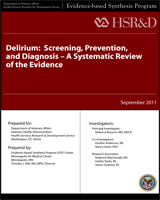Delirium: Screening, Prevention, and Diagnosis – A Systematic Review of the Evidence
Evidence-based Synthesis Program
Authors
Nancy Greer, PhD, Rebecca Rossom, MD, MSCR, Pauline Anderson, RN, Roderick MacDonald, MS, James Tacklind, BS, Indulis Rutks, BS, and Timothy J Wilt, MD, MPH.Affiliations
Delirium is a common syndrome in hospitalized or institutionalized adults. It is characterized by the acute onset of altered mental status, hallmarked by difficulty sustaining attention and a fluctuating course. Delirium frequently causes patients, families, and health care providers considerable distress. The incidence varies widely based on patient population, setting, and intensity of diagnostic ascertainment with reported values of 10% to over 80%. Delirium is associated with multiple serious outcomes including increased morbidity, length of hospital stay, healthcare costs, institutionalization, and mortality. In surgical settings, older adults and those with multiple medical conditions are at increased risk for postoperative delirium. Delirium may be under-recognized by healthcare providers and it can be difficult to resolve. Several brief “bedside” questionnaires and checklists exist that can help detect delirium earlier and among those with milder symptoms. Additionally, efforts to prevent the development of delirium in those at risk have been advocated. Medications (including sedatives, narcotics, and anticholinergic drugs), diseases and intercurrent illnesses (e.g., stroke, infection, shock, anemia), surgical procedures (especially orthopedic and cardiac surgery), and environmental factors (e.g., use of a bladder catheter, pain, and emotional stress) are all associated with delirium. Therefore, identifying and implementing effective strategies to prevent and detect delirium could improve clinical outcomes and resource utilization. Suggested strategies to prevent delirium include avoidance of psychoactive medications, pharmacologic interventions to decrease risk, and single- or multi-component non-pharmacologic interventions (including use of music, mobilization, fluid and nutrition management, and orientation and cognitive stimulation).
This review was undertaken to evaluate the effectiveness of screening for delirium, the effectiveness and harms of strategies to prevent delirium, and the comparative diagnostic accuracy of tools used to detect delirium.
Prepared for: Department of Veterans Affairs, Veterans Health Administration, Health Services Research & Development Service, Washington, DC 20420. Prepared by: Evidence-based Synthesis Program (ESP) Center, Minneapolis VA Medical Center, Minneapolis, MN, Timothy J. Wilt, MD, MPH, Director
Suggested citation:
Greer N, Rossom R, Anderson P, MacDonald R, Tacklind J, Rutks I, Wilt TJ. Delirium: Screening, Prevention, and Diagnosis - A Systematic Review of the Evidence. VA-ESP Project #09-009; 2011.
This report is based on research conducted by the Evidence-based Synthesis Program (ESP) Center located at the Minneapolis VA Medical Center, Minneapolis, MN funded by the Department of Veterans Affairs, Veterans Health Administration, Office of Research and Development, Health Services Research and Development. The findings and conclusions in this document are those of the author(s) who are responsible for its contents; the findings and conclusions do not necessarily represent the views of the Department of Veterans Affairs or the United States government. Therefore, no statement in this article should be construed as an official position of the Department of Veterans Affairs. No investigators have any affiliations or financial involvement (e.g., employment, consultancies, honoraria, stock ownership or options, expert testimony, grants or patents received or pending, or royalties) that conflict with material presented in the report.
